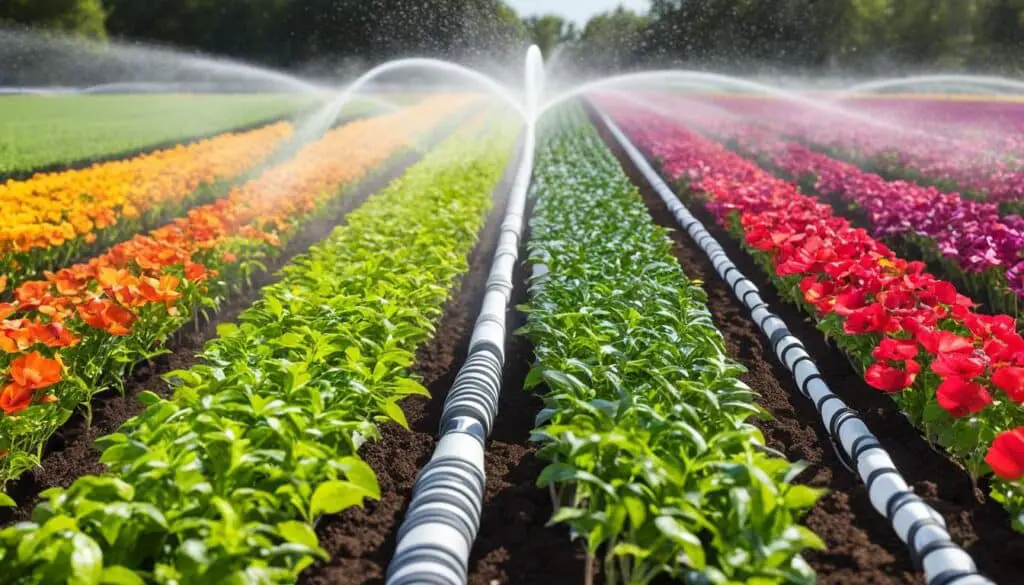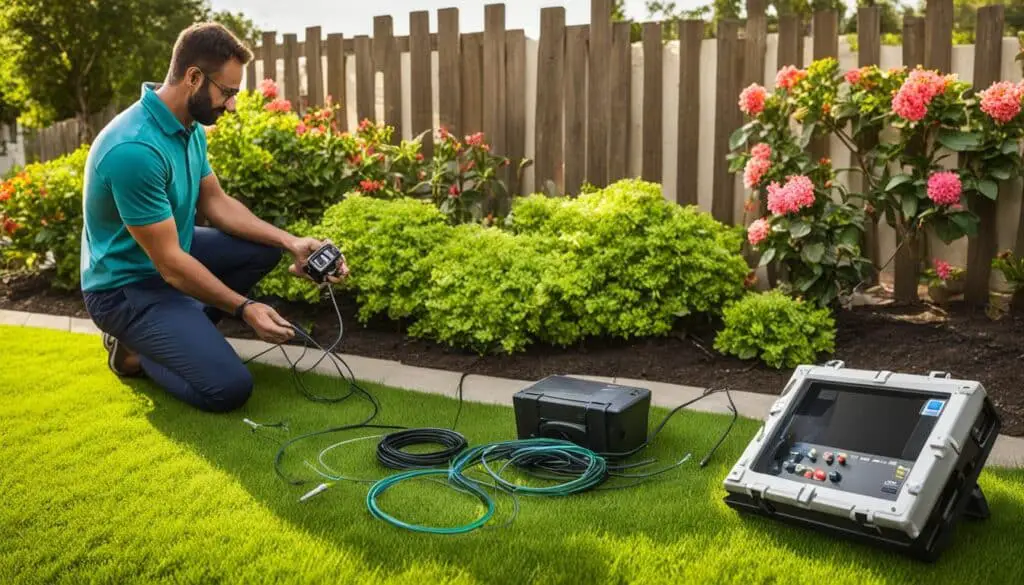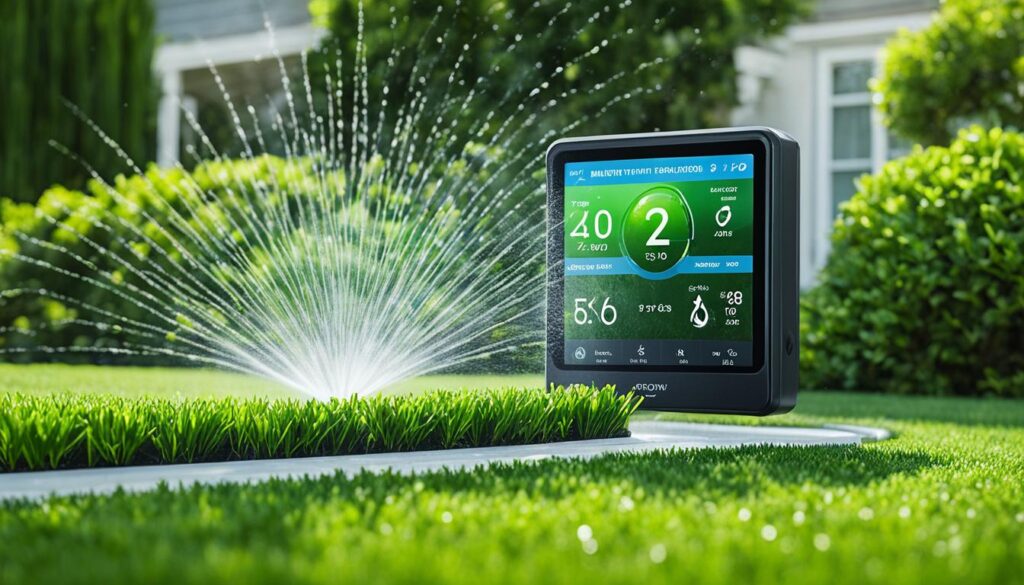If you dream of having a lush garden but worry about water consumption and the complexities of lawn care, smart irrigation systems are here to make your gardening experience easier and more efficient. These beginner-friendly systems utilize advanced technology to optimize watering schedules and conserve water, resulting in a beautiful and water-wise outdoor space.
In this guide, I will walk you through the process of setting up your own smart irrigation system, step-by-step. Whether you have a small garden or a sprawling landscape, this guide will help you navigate the world of smart irrigation and take control of your lawn care routine.
Table of Contents
Key Takeaways:
- Smart irrigation systems are designed to automate and optimize watering, resulting in a healthy and vibrant garden.
- Choosing the right system involves considering your specific needs and budget.
- Installation includes placing the controller and sensors at strategic locations, followed by system configuration.
- Programming and monitoring your system can be easily done through a mobile app or remote control.
- Regular maintenance and seasonal adjustments will ensure optimal water efficiency and plant health.
Understanding Smart Irrigation Systems
Smart irrigation systems revolutionize the traditional way of watering gardens through the integration of advanced technology. These systems are designed to automate and optimize the watering process, ensuring that your plants receive the right amount of water at the right time. With a strong focus on water conservation, smart irrigation systems help reduce water waste and minimize the environmental impact of conventional irrigation methods.
At the heart of smart irrigation systems are innovative features such as soil moisture sensors, weather data integration, and customizable watering schedules. These components work together to create a smart and efficient irrigation solution. By measuring the moisture levels in the soil, soil moisture sensors provide real-time data that enables the system to determine when and how much water should be applied to the plants. This ensures that water is delivered precisely when it’s needed, avoiding overwatering or underwatering.
Smart irrigation systems also take advantage of weather data to adjust watering schedules based on current and forecasted weather conditions. This feature helps prevent unnecessary watering during rainy periods and increases irrigation during dry spells. By adapting to the weather patterns, the system optimizes water usage and conserves this precious resource.
Customizable watering schedules are another key aspect of smart irrigation systems. With the ability to set specific watering times, duration, and frequency, you have full control over your garden’s irrigation needs. Whether you have different plant types with varying water requirements or specific times when watering is most effective, smart irrigation systems can accommodate your preferences.
Benefits of Smart Irrigation Systems:
- Efficient water usage through advanced technology
- Prevents overwatering and underwatering
- Reduces water waste and conserves resources
- Adapts to weather conditions for optimal irrigation
- Customizable schedules for different plant types
“Smart irrigation systems combine convenience and sustainability, making them an ideal choice for eco-conscious gardeners.” – [Name]
With smart irrigation systems, you can have peace of mind knowing that your garden is being watered efficiently and sustainably. By harnessing the power of advanced technology, these systems allow you to maintain a healthy and thriving garden while minimizing water usage. Embrace the future of irrigation and experience the benefits of smart irrigation systems.
Choosing the Right Smart Irrigation System
When it comes to choosing a smart irrigation system, it’s important to consider your specific needs and budget. With a wide range of options available, from DIY kits to professional installations, finding the right system for your garden is easier than ever.
First, take a look at the size of your garden and the types of plants you have. This will help determine the level of coverage and control you require from your smart irrigation system. If you have a small garden with a few plants, a basic DIY kit might be a budget-friendly option. However, if you have a larger garden with a variety of plants, you may need a more advanced system with customizable features.
Compatibility is another crucial factor to consider. Ensure that the smart irrigation system you choose is compatible with your existing irrigation setup. This will save you time and effort during the installation process. Most manufacturers provide detailed instructions on compatibility, so be sure to follow them closely.

- Consider your budget and needs
- Evaluate the size of your garden and types of plants
- Check compatibility with your existing irrigation setup
Once you have selected the ideal smart irrigation system, follow the manufacturer’s installation process. This process typically involves setting up the system’s controller and placing sensors strategically in your garden. By carefully following the installation instructions, you can ensure that your smart irrigation system functions effectively.
Remember, choosing a smart irrigation system is an investment in the long-term health and beauty of your garden. Take the time to evaluate your options, consider your budget, and select a system that meets your specific needs. With the right system in place, you can enjoy a well-maintained garden while conserving water and optimizing your irrigation efforts.
Installing Your Smart Irrigation System
Now that you have chosen the perfect smart irrigation system for your garden, it’s time to install it and start reaping the benefits of efficient watering. The installation process is straightforward and can be completed with just a few simple steps.
Controller Placement
The first step is to find a suitable location for the controller. This is the brain of your smart irrigation system, responsible for scheduling and regulating watering cycles. It is essential to place the controller in a convenient spot where it can be easily accessed and programmed.
Consider these factors when choosing the controller placement:
- Accessibility: Ensure the controller is easily reachable, especially if you need to make adjustments or reprogram it.
- Protection: Avoid placing the controller in areas prone to extreme weather conditions, such as direct sunlight or heavy rain. Opt for a sheltered spot to protect it from the elements.
- Wi-Fi Signal: If your smart irrigation system relies on wireless connectivity, make sure the controller is within range of a stable Wi-Fi signal for seamless communication.
Once you have found the ideal location, securely mount the controller using the provided hardware or brackets. Now, you’re one step closer to a well-maintained garden!
Sensor Placement
In addition to the controller, sensors play a crucial role in maximizing the efficiency of your smart irrigation system. The placement of sensors is vital for accurate measurements of moisture levels and rainfall. Different types of sensors, such as soil moisture sensors or rain sensors, serve specific purposes in optimizing water usage.
Here are a few guidelines for sensor placement:
- Soil Moisture Sensors: Install these sensors at strategic locations throughout your garden, ensuring they are placed in representative areas. This will provide accurate readings of soil moisture throughout your entire outdoor space.
- Rain Sensors: These sensors detect rainfall and temporarily interrupt the watering cycle to prevent unnecessary watering. Place rain sensors in an open area away from obstacles that could block rainwater.
Take the time to position the sensors correctly according to the manufacturer’s instructions. This will ensure precise data collection and reliable performance from your smart irrigation system.
System Configuration
Once the physical installation is complete, it’s time to configure the settings of your smart irrigation system. This step involves tailoring the system to suit the unique needs of your garden, such as setting watering schedules and adjusting parameters based on the types of plants you have.
Refer to the system’s user manual or the manufacturer’s online resources for detailed instructions on how to configure your specific smart irrigation system. The configuration process may involve:
- Setting watering schedules: Determine when and how long each zone of your garden needs to be watered.
- Adjusting moisture thresholds: Fine-tune the moisture levels that trigger the irrigation system, ensuring your plants receive adequate hydration without waste.
- Personalizing plant profiles: Some smart irrigation systems allow you to create profiles for different types of plants, enabling customized watering based on their specific water requirements.
By taking the time to configure your smart irrigation system properly, you’ll optimize water usage, conserve resources, and promote the overall health and beauty of your garden.

With the controller in place, sensors strategically positioned, and system settings configured, your smart irrigation system is now fully installed and ready to revolutionize your garden’s watering routine.
Programming and Monitoring Your Smart Irrigation System
Once you have successfully installed your smart irrigation system, it’s time to program it to suit your garden’s unique watering needs. Thankfully, most smart irrigation systems offer user-friendly mobile apps and remote control options, making it incredibly convenient to adjust settings and monitor water usage right from your smartphone or device.
Take advantage of these intuitive features to customize watering schedules, receive notifications, and track water consumption with ease. With just a few taps on your mobile app or remote control, you can ensure that your plants receive the perfect amount of water while avoiding wastage.
Programming your smart irrigation system allows you to set up customized watering schedules that align perfectly with your garden’s needs. Whether you have different plant types or specific watering requirements, your smart system can accommodate it all. By tailoring your watering schedule, you can provide optimal moisture levels for your plants, ensuring their health and vitality.
Monitoring Water Usage and Conservation
One of the most significant advantages of smart irrigation systems is their ability to monitor water usage. By tracking how much water your system is using, you can identify any potential areas for improvement and take action to conserve water.
With the help of your smart irrigation system’s mobile app or remote control, you can keep a close eye on your water consumption in real-time. This feature allows you to stay proactive and informed about your usage, empowering you to make necessary adjustments to enhance water efficiency.
Having access to real-time water usage data helps me make smarter choices when it comes to conserving water in my garden. I can adjust the watering settings as needed and ensure that every drop counts.
Moreover, monitoring your water usage can help you detect any abnormalities or inefficiencies in your system. If you notice a sudden increase in water usage, it may indicate a leak or malfunction that requires your attention. Identifying and addressing these issues promptly can save you both water and money in the long run.
Regularly monitoring and adjusting your smart irrigation system will not only ensure optimal water efficiency but also promote the overall health of your plants. By providing the right amount of water at the right time, you can prevent overwatering or underwatering, reducing the risk of plant stress or diseases.
Tracking and Evaluating the Benefits
In addition to monitoring water usage, utilizing the mobile app or remote control enables you to track and evaluate the benefits of your smart irrigation system on your garden’s health and appearance. By keeping an eye on key indicators, such as plant growth, soil moisture levels, and general plant health, you can see firsthand how your efforts and adjustments translate into a flourishing and vibrant garden.
Regularly reviewing and analyzing this data empowers you to make further improvements and refinements to your watering schedules and overall irrigation system. With time, you’ll become more adept at fine-tuning your settings to achieve an optimal balance between water conservation and plant vitality.
To maximize the benefits, it is recommended to perform periodic audits of your smart irrigation system, reviewing and adjusting settings as needed. This proactive approach will ensure that your system remains efficient and effective year-round.
Additional Tips for Smart Irrigation Success
To maximize the benefits of your smart irrigation system, there are a few additional tips to keep in mind. Regular maintenance, such as cleaning sensors and checking for leaks, will ensure the system operates smoothly. Additionally, consider making seasonal adjustments to your watering schedule to account for temperature and rainfall changes. By optimizing water efficiency and plant health, you’ll achieve a vibrant and thriving garden with minimal effort.
Regular Maintenance
Keeping your smart irrigation system well-maintained is crucial for its optimal performance. Regularly clean the sensors to ensure accurate readings of soil moisture levels. This will allow the system to adjust watering schedules accordingly, saving water and preventing over- or under-watering of your plants. Additionally, regularly check for leaks or damaged components and promptly repair or replace them as needed.
Seasonal Adjustments
As the seasons change, so do the watering needs of your garden. Adjusting your smart irrigation system’s watering schedule accordingly is essential to ensure your plants receive the right amount of water. Take into account factors such as temperature, humidity, and rainfall when making these adjustments. For example, during hotter months, you may need to increase the frequency or duration of watering, while during cooler months, you may need to decrease it.
Pro Tip: By making seasonal adjustments, you can optimize your watering schedule and promote healthier plant growth. It’s always best to monitor your garden’s condition and make adjustments based on its specific needs.
Optimizing Water Efficiency
One of the key advantages of a smart irrigation system is its ability to optimize water usage, promoting water efficiency. To further maximize this efficiency, consider implementing additional strategies. For example, grouping plants with similar water needs together can prevent overwatering or underwatering of certain areas. Mulching around plants helps retain soil moisture and reduces water evaporation. By combining these practices with your smart irrigation system, you’ll significantly reduce water waste and promote sustainable gardening.
| Smart Irrigation Tips |
|---|
| 1. Clean sensors regularly to ensure accurate readings. |
| 2. Check for leaks or damaged components and repair them promptly. |
| 3. Make seasonal adjustments to your watering schedule based on temperature and rainfall. |
| 4. Group plants with similar water needs together to optimize watering efficiency. |
| 5. Mulch around plants to retain soil moisture and reduce evaporation. |
By following these additional tips for smart irrigation success, you’ll not only optimize water usage but also create a thriving, vibrant garden with minimal effort. The combination of regular maintenance, seasonal adjustments, and optimizing water efficiency will ensure the long-term success of your smart irrigation system.
Conclusion
Setting up a beginner-friendly smart irrigation system is the perfect solution to simplify your lawn care routine and achieve a lush, water-wise garden. By understanding the basics of these systems and selecting the right one for your needs, you’ll be well on your way to optimizing water usage and maintaining healthy plants.
With the help of advanced technology, such as soil moisture sensors and customizable schedules, these smart irrigation systems take the guesswork out of watering your garden. Not only will you enjoy the beauty of a vibrant and thriving garden, but you’ll also contribute to water conservation efforts.
Now is the time to start setting up your very own smart irrigation system. Follow the installation and programming steps provided, and you’ll experience the convenience and benefits for years to come. Say goodbye to complicated watering schedules and hello to simplified lawn care. Let technology work for you and enjoy the lush garden of your dreams while conserving our precious water resources.
FAQ
What is a smart irrigation system?
A smart irrigation system is designed to automate and optimize the watering process in your garden. It utilizes advanced technology, such as soil moisture sensors and weather data, to ensure your plants receive the right amount of water at the right time. These systems also prioritize water conservation and have customizable schedules to reduce water waste.
How do I choose the right smart irrigation system?
When choosing a smart irrigation system, consider factors such as the size of your garden, the types of plants you have, and your desired level of control. Take into account your specific needs and budget, and ensure that the system you choose is compatible with your existing irrigation setup. Follow the installation process provided by the manufacturer to ensure a smooth setup.
What is involved in installing a smart irrigation system?
Installing a smart irrigation system typically involves placing the controller in a convenient location for easy access and programming. Sensors, such as soil moisture sensors or rain sensors, should be strategically placed in the garden to accurately measure moisture levels and rainfall. After the physical installation is complete, you’ll need to configure the system settings according to your garden’s specific needs.
How do I program and monitor my smart irrigation system?
Most smart irrigation systems offer user-friendly mobile apps or remote control options for programming and monitoring. These features allow you to customize watering schedules, receive notifications, and track water consumption. Take advantage of these tools to optimize water efficiency and ensure your plants are healthy.
What are some additional tips for smart irrigation success?
Regular maintenance, such as cleaning sensors and checking for leaks, will keep your smart irrigation system operating smoothly. Additionally, consider making seasonal adjustments to your watering schedule to account for temperature and rainfall changes. By optimizing water efficiency and plant health, you’ll achieve a vibrant and thriving garden with minimal effort.


